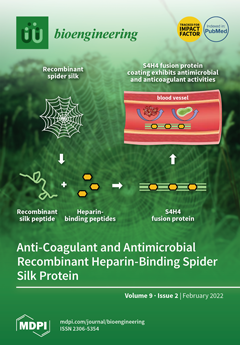Sigma factors and sigma factor-related mechanisms control antibiotic production in
Streptomyces. In this contribution, the
orf21 gene was overexpressed in the wild-type strain of
Streptomyces clavuligerus ATCC2764, yielding
S. clavuligerus/pIORF21, to further evaluate its regulatory effect on clavulanic acid (CA) biosynthesis
[...] Read more.
Sigma factors and sigma factor-related mechanisms control antibiotic production in
Streptomyces. In this contribution, the
orf21 gene was overexpressed in the wild-type strain of
Streptomyces clavuligerus ATCC2764, yielding
S. clavuligerus/pIORF21, to further evaluate its regulatory effect on clavulanic acid (CA) biosynthesis under different culture medium conditions. The
orf21 overexpression, regulated under the constitutive promoter
ermE*, led to 2.6-fold increase in CA production in GSPG medium, and a 1.8-fold decrease using ISP medium. As for GYM and MYM media,
S. clavuligerus/pIORF21 strain showed higher aerial mycelium production compared to control. Glycerol uptake rate profile was affected by
orf21 overexpression. Furthermore, in GSPG,
S. clavuligerus/pIORF21 slightly increased the expression of
adpA and
gcas genes, whilst, in ISP, the
claR gene expression was drastically reduced, which is consistent with a decreased CA production, observed in this medium. These findings suggest the protein encoded by the
orf21 gene plays a role in the regulation of CA biosynthesis as a response to the nutritional composition of the medium.
Full article






